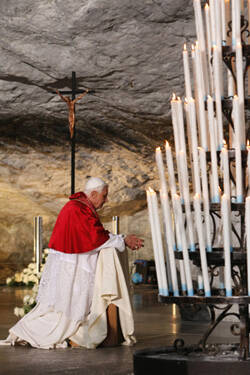Marys Smile
Much of the media coverage of Pope Benedict XVI’s recent visit to France focused on his more overtly political talks, including his desire for a “positive laïcité” in the country. But during his visit to Lourdes to mark the 150th anniversary of the apparitions to St. Bernadette Soubirous, the pope spoke in a more devotional mode. Standing before the Basilica of Our Lady of the Rosary, Benedict reminded the faithful that one of the first “acts” of Mary toward Bernadette was a simple, personal gesture. “Mary first taught Bernadette to know her smile, this being the most appropriate point of entry into the revelation of her mystery. In the smile of the most eminent of all creatures, looking down on us, is reflected our dignity as children of God, that dignity which never abandons the sick person.”
Benedict’s combination of a scholarly approach to worldly questions and his embrace of something as “otherworldly” as apparitions underlines the fine balance that a Catholic must maintain. Involvement in real-world issues does not mean that one does not believe in the possibility of things that intellectuals sometimes reject—like apparitions and miracles. At the same time, the church is not credulous. Shortly before the pope’s visit to Lourdes, the Vatican announced that it was initiating steps to avoid “excesses and abuses” in the church’s acceptance of apparitions, and it disciplined one of the main spiritual directors for the original visionaries at Medjugorje, a popular shrine that has been viewed with some suspicion in Rome. Benedict’s words at Lourdes show once again that reason and faith are complementary.
The Coming New Majority
This fall, more Latino students will take a seat in our nation’s public schools than ever before: 10 million children, one of every five enrolled in kindergarten through high school. That total has nearly doubled since 1990, according to a recent report by the Pew Hispanic Center, and it is expected to double again by 2050—to 28 million. If it does, Latinos would then make up the majority of the U.S. school-age population. Are public schools adequately prepared to teach them? Do teachers and parents understand Latino cultures, the bilingual family and the particular needs such students may have? Are those who are not Latino preparing themselves to acknowledge Latinos as the new majority, and to see themselves as members of a minority group?
Already, regions with large Latino populations are adapting to the bi- or multilingual and multicultural reality. Two years ago in California, nearly half of all public school students were Latino, and many such children attend school in Texas, Arizona, New Mexico, Nevada, Colorado, Illinois, Florida and New York. Although more than half of all Latino students in the nation are attending schools in Texas or California this fall, Latinos, especially the foreign-born, are moving rapidly to other parts of the country, where local schools may be less prepared for them.
To be effective, educators must take into account three key dimensions of the Latino student profile: first, most live in two-parent households. The rate is 71 percent among U.S.-born students of immigrant parents, which is a little higher than that of non-Latino white students and much higher than non-Latino black students (30 percent). Second, more than a quarter of Latino children live in poverty. Third, 7 in 10 speak a language other than English at home. Taking these factors into account could help schools and local communities reach out to the next majority.
Relics Secular and Sacred
Nonbelievers are not the only ones who smile at or even ridicule Catholics for their veneration of relics. Even non-Catholic Christians criticize Catholics for this strand of our tradition. Yet when one reads about the dollars paid for a piece of Yankee Stadium, one begins to wonder. Memorabilia have become big business, with stores that sell sport, pop star and Civil War memorabilia. Might one call them relics?
Devoted fans pay $869 to carry away two seats from Shea Stadium. Bases go for $1,500. Dirt from the razed Tiger Stadium sells for $20. A urinal from Busch stadium went for $2,220. Total sales of memorabilia from that late stadium added up to $5.4 million. But New York is unusual: the sale of Yankee Stadium memorabilia is expected to amount to $50 million.
Baseball stars themselves want a piece of the action. On the last night at the House That Ruth Built, Don Larsen, Mariano Rivera and many others reached down to scoop handfuls of dirt from the pitching mound into plastic cups.
Something in the human psyche does not want to let go but to remember, to keep continuity with the best of our past. We need ways to remember the good, the true and the enjoyable—not all that different from the Catholic tradition, which for centuries has venerated the bones and clothing of its heroes in holiness. Perhaps veneration of saints’ relics was simply a bit ahead of the times.








